华中科技大学 计算机 0907
华中科技大学 计算机
0907 朱胜本朱胜本
实验二 驱动程序
要求:掌握添加设备驱动程序的方法
内容:
采用模块方法,添加一个新的设备驱动程序。
要求添加字符设备的驱动。
编写一个应用程序,测试添加的驱动程序。
linxu 系统中,在应用程序看来,硬件设备只是一个设备文件,应用程序可以象操作普通文件一样对硬件
设备进行操作。设备驱动程序是内核的一部分,它完成以下的功能:
1.对设备初始化和释放.
2.把数据从内核传送到硬件和从硬件读取数据.
3.读取应用程序传送给设备文件的数据和回送应用程序请求的数据.
4.检测和处理设备出现的错误.
设备分为两种:字符设备和块设备,这里就以简单的字符设备为例。
在设备驱动程序中有一个非常重要的结构 file_operations,该结构的每个域都对应着一个系统调用。用户
进程利用系统调用在对设备文件进行诸如 read/write 操作时,系统调用通过设备文件的主设备号找到相应
的设备驱动程序,然后读取这个数据结构相应的函数指针,接着把控制权交给该函数。
struct file_operations {
, off_t ,int);
, char ,int);
, off_t ,int);
int(*seek) (struct inode * ,structfile *
int (*read) (struct inode * ,structfile *
int (*write) (struct inode * ,structfile *
……
}
编写设备驱动程序的主要工作是编写子函数,并填充 file_operations 的各个域。
例如:
Structfile_operations my_fops={
.read=my_read,
.write=my_write,
.open=my_open,
.release=my_release
}
然后再定义函数 my_read,my_write,my_open,my_release 相应的函数体。
例如:
�
华中科技大学 计算机 0907
华中科技大学 计算机
0907 朱胜本朱胜本
staticssize_t my_open(struct inode *inode,struct file *file){
staticint counter=0;
if(Device_Open)
return-EBUSY;
Device_Open++;
/*写入设备的信息*/
sprintf(msg,"the device hasbeen called %d times\n",counter++);
msg_ptr=msg;
return0;
}
同时对于可卸载的内核模块(LKM),至少还有两个基本的模块:
my_init 用于注册设备,获得设备的主设备号
调用 register_chrdev(0,“sky_driver(设备名)”,&my_fops);
my_exit 用于注销设备
调用 unregister_chrdev(my_major,“sky_driver(设备名)”);
然后在程序尾再调用这两个函数
Module_init(my_init);
Module_exit(my_exit)
MODULE_LICENSE(“GPL”);
不过如果使用特殊函数名
init_module 和 cleanup_module,
就不用在程序最后加上上面那三行代码了。
废话少说,以下是实验过程:
首先编写驱动程序。
将后面附上的 3 个源程序放在一个文件夹中后(也可直接打包下载
http://download.csdn.net/detail/creazyapple/4088141)
,开始进行实验:
1.编译驱动程序.
在控制台下进入文件所在目录,输入命令 make。如图:
�
华中科技大学 计算机 0907
华中科技大学 计算机
0907 朱胜本朱胜本
看到了吗?提示错误。原来需要用超级用户权限。
没有错误提示,说明 make 成功,进入文件夹下可以看到多了一些.k,.ko 之类的文件。这就是编译好的
模块。
2. 装载模块。
同样,必须要是 root 下才能进行。装载前,我们可以先看看系统中的模块:lsmod
装载,输入命令: insmod devDrv.ko
完成后,再看看系统中的模块,发现多了一个模块 devDrv”,表示我们成功加载了!
“
可以用命令查看系统日志信息:dmesg
看到如下信息:
这正是在我们的驱动程序中注册函数输出的内容哦!
�
华中科技大学 计算机 0907
华中科技大学 计算机
0907 朱胜本朱胜本
3.分配次设备号。
每个文件都有两个设备号,第一个是主设备号,标识驱动程序,第二个是从设备号,标识使用同一个设
备驱动程序的不同的硬件设备,比如有两个软盘,就可以用从设备号来区分他们.设备文件的的主设备号
必须与设备驱动程序在登记时申请的主设备号一致,否则用户进程将无法访问到驱动程序.。
分配前,我们必须要知道主设备号(其实在上一步中我们从 dmesg 中已经看到主设备好为 250
cat /proc/devices
):
可见到这一行:250 myDevice,是了,主设备号为 250.
现在我们分配从设备号:mknod /dev/myDevice c 250 0
实际上就是在虚拟文件夹/dev/中加一个设备(在系统看来是文件)myDevice ,注意,这个是设备名,在
测试文件中真是要利用这个设备名打开设备。最后的 0 表示从设备号。可以随便分配(只要不冲突)。
此后便可以在/dev/目录下看到新建的设备 myDevice 了:ls /dev/
一切成功的话,就可以测试我们的驱动程序啦!
4.测试驱动程序。
首先要编译测试程序:gcc drvTest.c -o sb
得到 sb
可执行程序,再执行 :./sb
测试程序首先列出所有的设备名,让我们选中一个,当然输入 myDevice 啦:
正确读出之前存放在设备中的字符串!然后提示让我们输入一个字符串,随便啦:
�
华中科技大学 计算机 0907
华中科技大学 计算机
0907 朱胜本朱胜本
最后是不是正确保存、读出了呢?of course !而且还告诉我们调用了几次这个设备呢!
5.删除设备、模块。
首先删除设备。就像删除普通文件一样:rm /dev/myDevice
删除后,看看/dev/目录下是佛已经木有 myDevice 啦?:ls /dev/
接着删除模块:rmmod devDrv.
看看模块列表中是否已经没有 devDrv 模块了?:lsmod
在本次实验中,还特别添加了一些代码来给设备上锁,实现互斥,以免同时有多个进程读取设备造成混
乱。(一般来说,字符设备如打印机是不能共享滴。。)观察驱动程序 devDrv.c 中两个函数
static int my_open(struct inode *inode, struct file *file)
{
if(mutex)
�
华中科技大学 计算机 0907
华中科技大学 计算机
0907 朱胜本朱胜本
return -EBUSY;
mutex = 1;//上锁
printk("<1>main device : %d\n", MAJOR(inode->i_rdev));
printk("<1>slave device : %d\n", MINOR(inode->i_rdev));
printk("<1>%d times to call the device\n", ++counter);
try_module_get(THIS_MODULE);
return 0;
}
/* 每次使用完后会 release */
static int my_release(struct inode *inode, struct file *file)
{
printk("Device released!\n");
module_put(THIS_MODULE);
mutex = 0;//开锁
return 0;
}
int 型 mutex 就是用来上锁的,它被初始化为 0,一旦使用该设备,就首先要调用 my_open 函数,将
mutex 设置为 1,如果此后还想使用该设备,必然因为 mutex 为 1 而返回-EBUSY,而终止。使用完该设
备后,调用 my_release 释放设备,将 mutex 重新设回 0.
特别注意,还有一个 counter 变量,使用来计量使用次数的。
makefile 的格式相当严格,比如不能用 8 个空格来代替一个 table 键等。
makefile 最后有一句:
devDrv 一定要对应我们要编译的驱动程序 devDrv.c 的文件名。
源代码附上。共三个文件,将其放在一个
文件夹中
devDrv.c
1. 驱动程序
#include "linux/kernel.h"
#include
"linux/module.h"
#include "linux/fs.h"
#include
"linux/init.h"
#include "linux/types.h"
#include "linux/errno.h"
#include
"linux/uaccess.h"
#include "linux/kdev_t.h"
�
#define MAX_SIZE 1024
华中科技大学 计算机 0907
华中科技大学 计算机
0907 朱胜本朱胜本
static int my_open(struct inode *inode, struct file *file);
static int my_release(struct inode *inode, struct file *file);
static
ssize_t my_read(
*f);
static
ssize_t my_write(
loff_t *f);
const
struct
file *file,
struct
file *file,
char
char
__user *user, size_t t, loff_t
__user *user, size_t t,
static char message[MAX_SIZE] = "-------congratulations--------!";
static int device_num = 0;//设备号
static int counter = 0;//计数用
static int mutex = 0;//互斥用
static char* devName = "myDevice";//设备名
struct file_operations pStruct =
{ open:my_open, release:my_release, read:my_read, write:my_write, };
注册模块 */
/*
int init_module()
{
int ret;
/* 函数中第一个参数是告诉系统,新注册的设备的主设备号由系统分配,
* 第二个参数是新设备注册时的设备名字,
* 第三个参数是指向file_operations的指针,
* 当用设备号为0
ret = register_chrdev(0, devName, &pStruct);
if (ret < 0)
{
创建时,系统一个可以用的设备号创建模块 */
printk("regist failure!\n");
return -1;
}
else
{
printk("the device has been registered!\n");
device_num = ret;
printk("<1>the virtual device's major number %d.\n", device_num);
printk("<1>Or you can see it by using\n");
printk("<1>------more /proc/devices-------\n");
printk("<1>To talk to the driver,create a dev file with\n");
printk("<1>------'mknod /dev/myDevice c %d 0'-------\n",
device_num);
printk("<1>Use \"rmmode\" to remove the module\n");
return 0;
}
注销模块,函数名很特殊 */
}
/*
void cleanup_module()
{
unregister_chrdev(device_num, devName);
printk("unregister it success!\n");
}
static int my_open(struct inode *inode, struct file *file)
{
if (mutex)
return -EBUSY;
mutex = 1;//上锁
printk("<1>main device : %d\n", MAJOR(inode->i_rdev));
�
华中科技大学 计算机 0907
华中科技大学 计算机
0907 朱胜本朱胜本
printk("<1>slave device : %d\n", MINOR(inode->i_rdev));
printk("<1>%d times to call the device\n", ++counter);
try_module_get(THIS_MODULE);
return 0;
}
/* 每次使用完后会release */
static int my_release(struct inode *inode, struct file *file)
{
printk("Device released!\n");
module_put(THIS_MODULE);
mutex = 0;//开锁
return 0;
}
static
*f)
{
if (copy_to_user(user,message,
{
return
-EFAULT;
}
return
}
sizeof
(message);
static
ssize_t my_write(
loff_t *f)
{
if (copy_from_user(message,user,
{
return
-EFAULT;
}
return
}
sizeof
(message);
ssize_t my_read(struct file *file,
char
__user *user, size_t t, loff_t
sizeof
(message)))
const
struct
file *file,
char
__user *user, size_t t,
sizeof
(message)))
2.makefile 文件。注意,文件名就叫 makefile 或者 Makefile,大小写不可随意更改,关于 makefile 的编
写,参考
http://wiki.ubuntu.org.cn/index.php?title=%E8%B7%9F
%E6%88%91%E4%B8%80%E8%B5%B7%E5%86%99Makefile:MakeFile%E4%BB%8B%E7%BB
%8D&variant=zh-cn
# If KERNELRELEASE is defined, we've been invoked from the
# kernel build system and can use its language.
ifeq ($(KERNELRELEASE),)
# Assume the source tree is where the running kernel was built
# You should set KERNELDIR in the environment if it's elsewhere
KERNELDIR ?= /lib/modules/$(shell uname -r)/build
# The current directory is passed to sub-makes as argument
PWD := $(shell pwd)
modules:
modules_install:
$(MAKE) -C $(KERNELDIR) M=$(PWD) modules
$(MAKE) -C $(KERNELDIR) M=$(PWD) modules_install
�
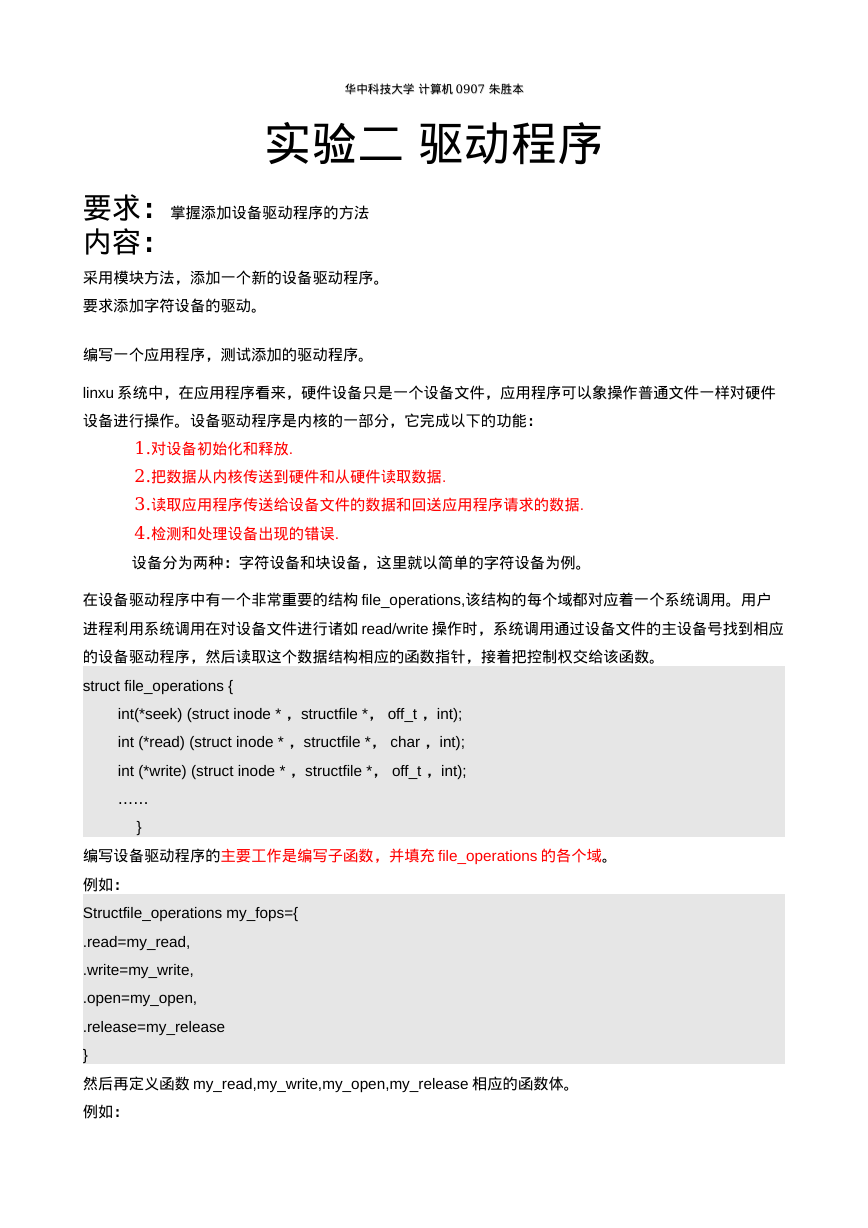
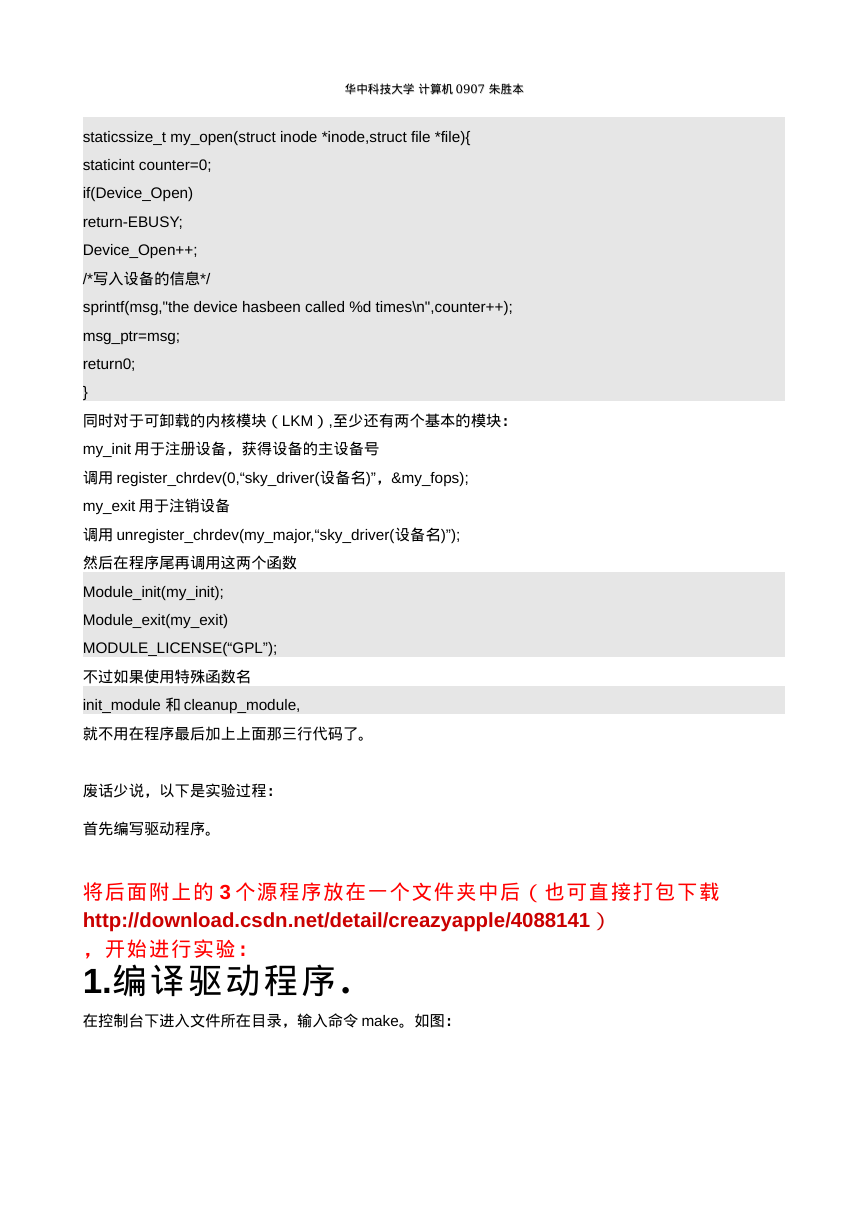
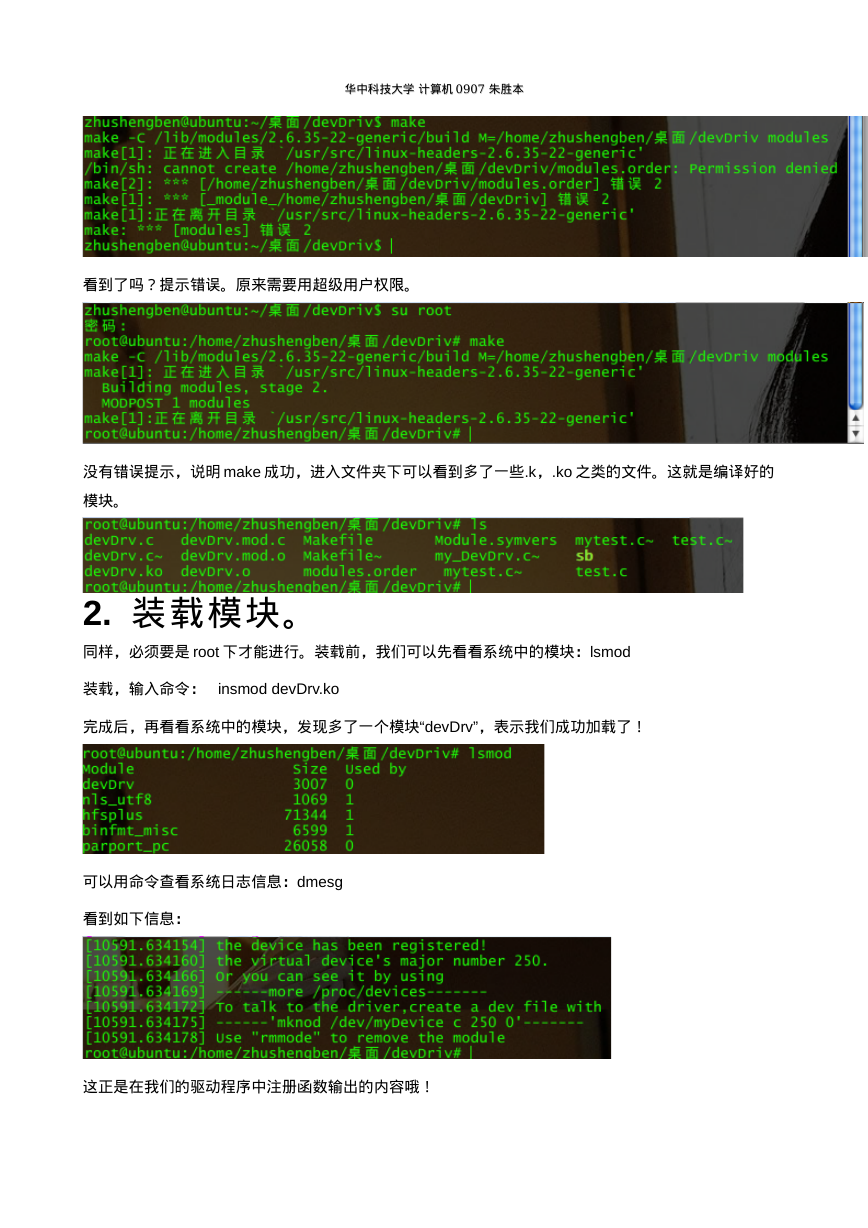
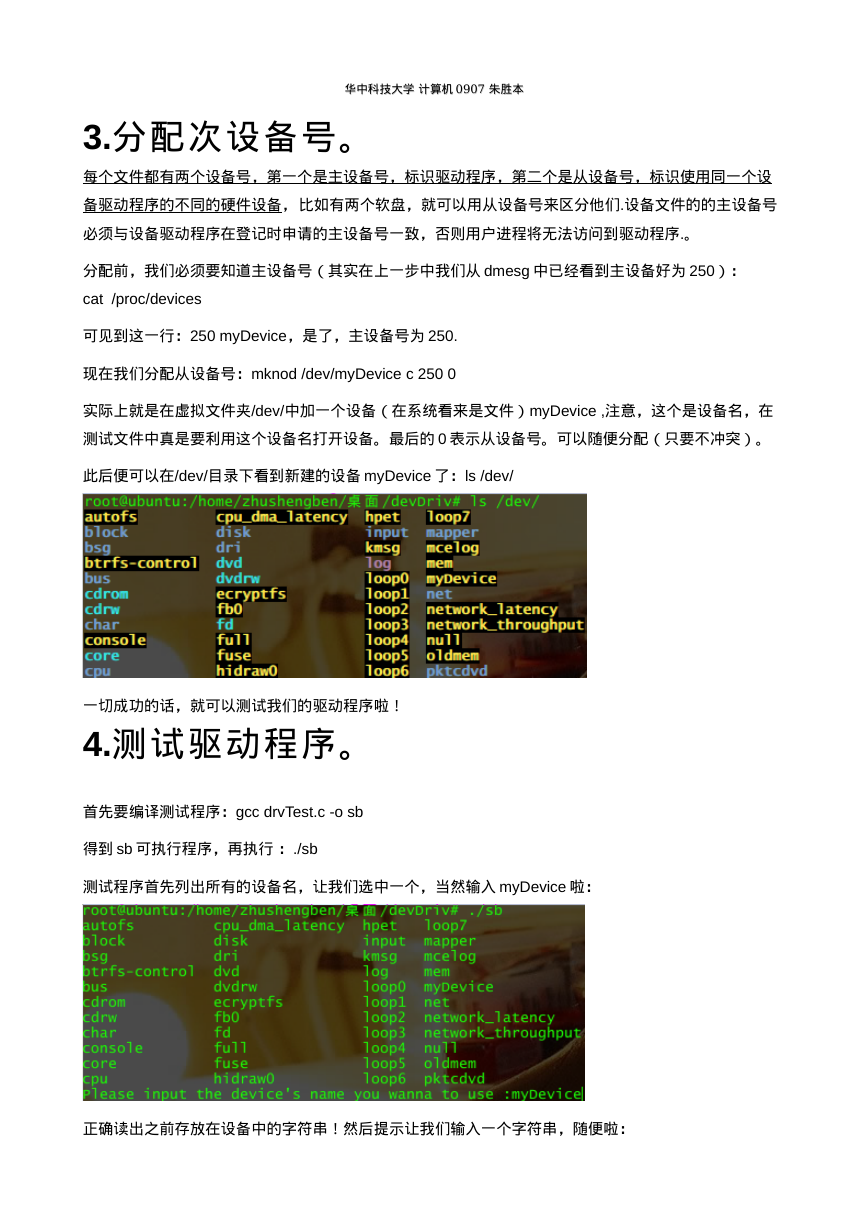
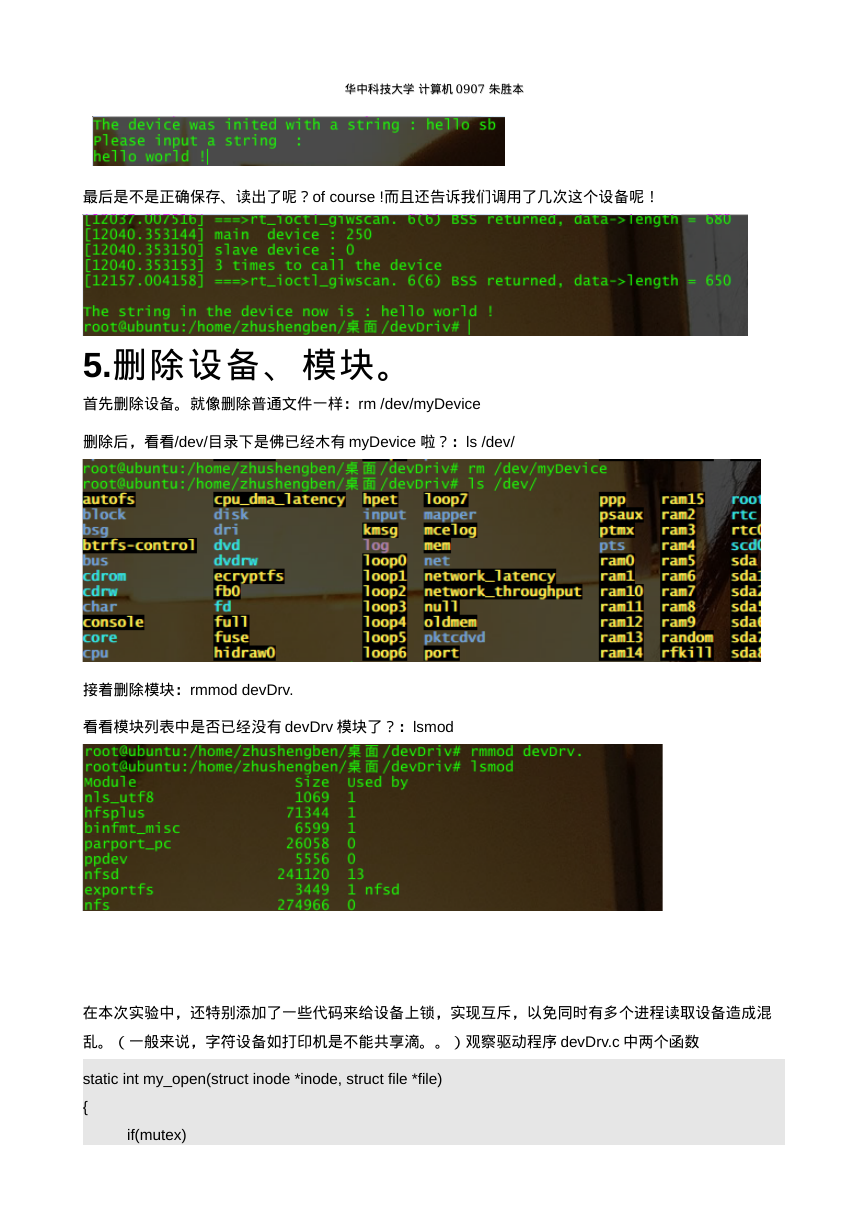
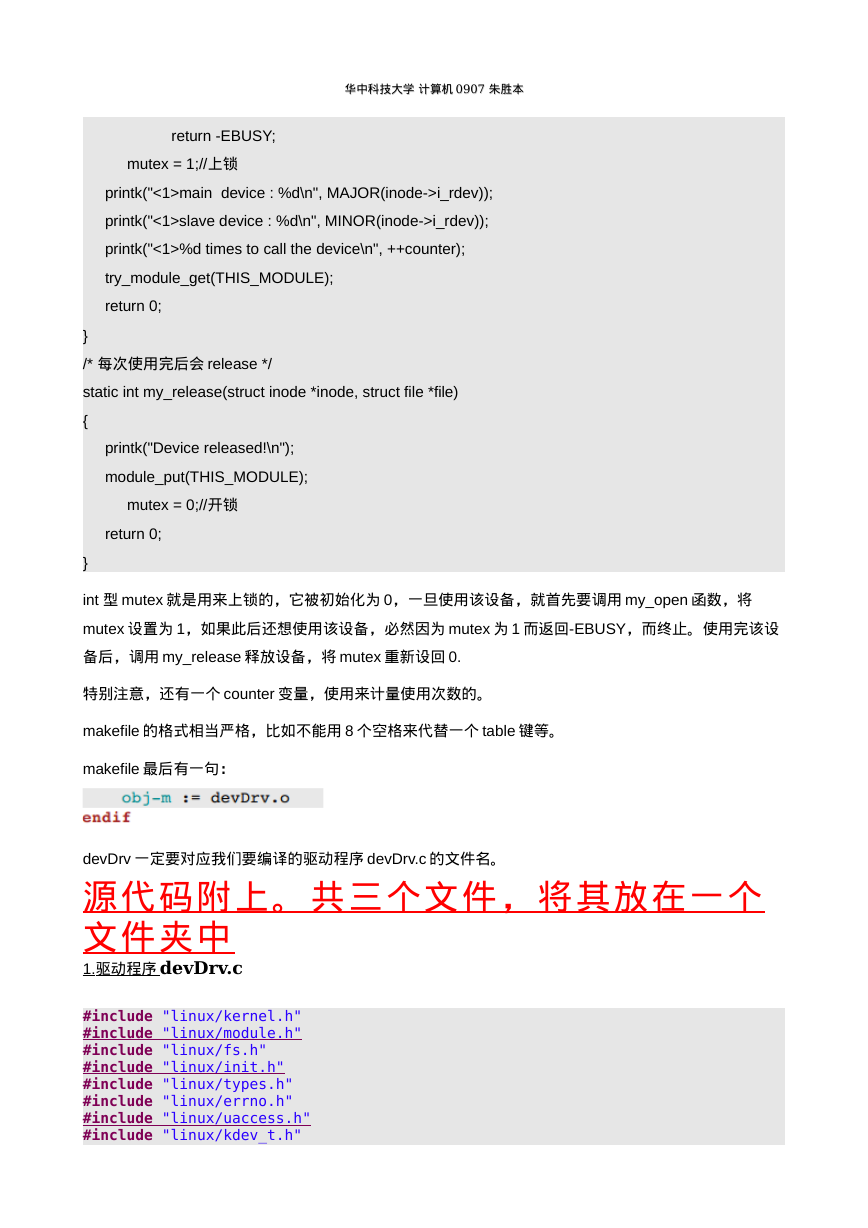
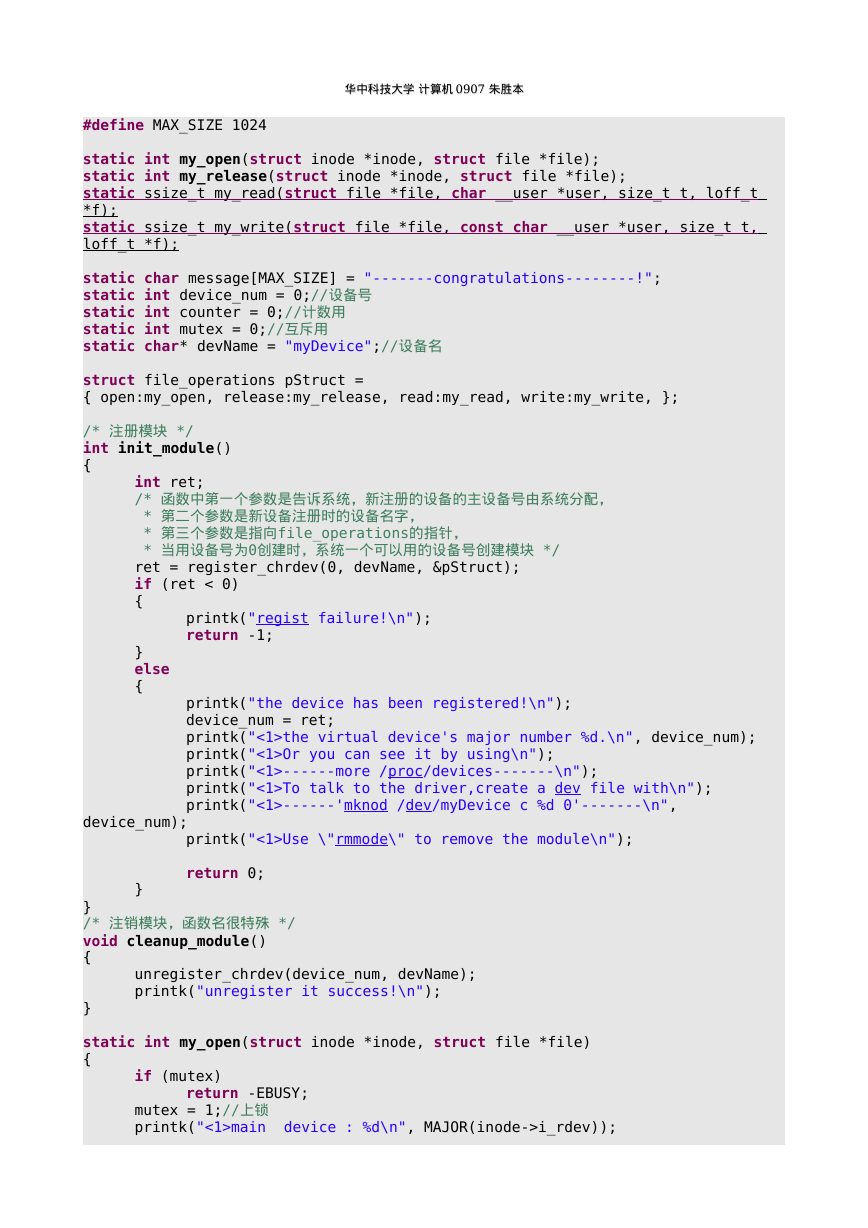
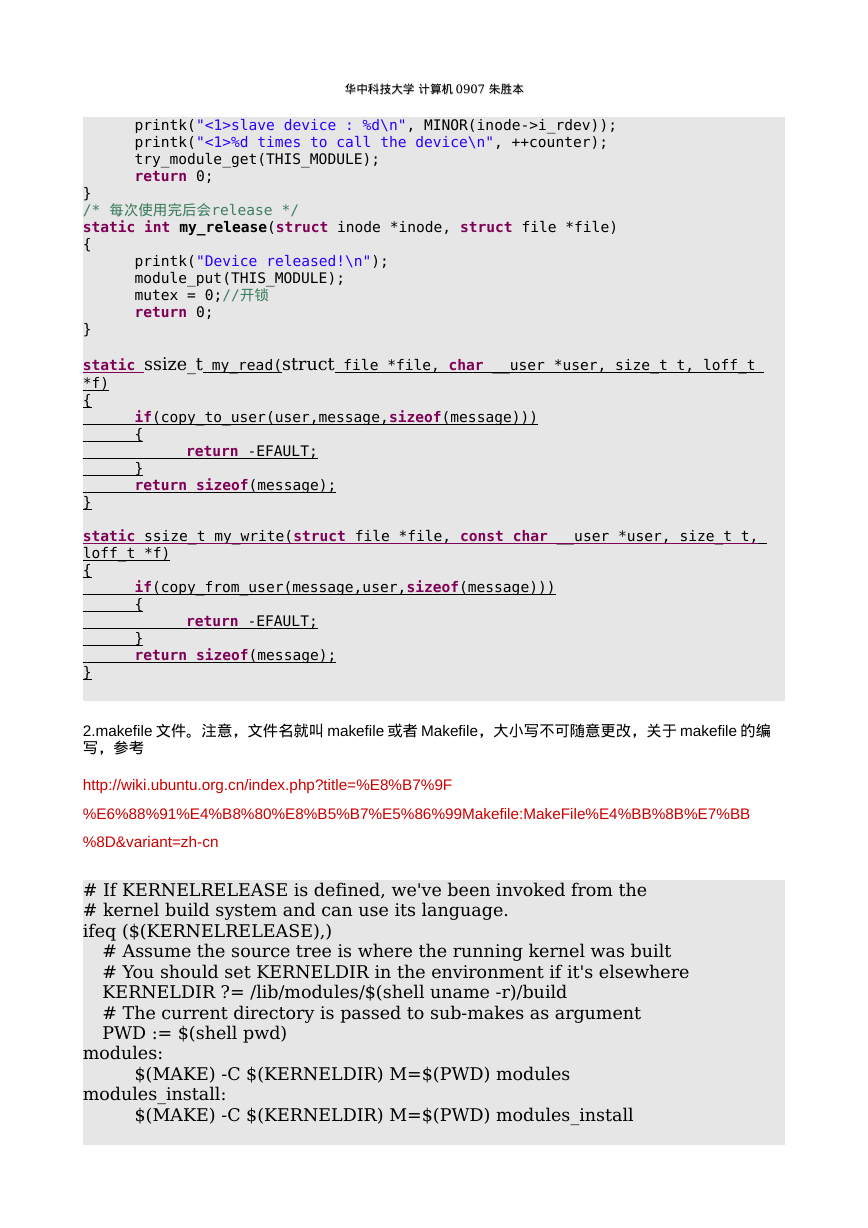








 2023年江西萍乡中考道德与法治真题及答案.doc
2023年江西萍乡中考道德与法治真题及答案.doc 2012年重庆南川中考生物真题及答案.doc
2012年重庆南川中考生物真题及答案.doc 2013年江西师范大学地理学综合及文艺理论基础考研真题.doc
2013年江西师范大学地理学综合及文艺理论基础考研真题.doc 2020年四川甘孜小升初语文真题及答案I卷.doc
2020年四川甘孜小升初语文真题及答案I卷.doc 2020年注册岩土工程师专业基础考试真题及答案.doc
2020年注册岩土工程师专业基础考试真题及答案.doc 2023-2024学年福建省厦门市九年级上学期数学月考试题及答案.doc
2023-2024学年福建省厦门市九年级上学期数学月考试题及答案.doc 2021-2022学年辽宁省沈阳市大东区九年级上学期语文期末试题及答案.doc
2021-2022学年辽宁省沈阳市大东区九年级上学期语文期末试题及答案.doc 2022-2023学年北京东城区初三第一学期物理期末试卷及答案.doc
2022-2023学年北京东城区初三第一学期物理期末试卷及答案.doc 2018上半年江西教师资格初中地理学科知识与教学能力真题及答案.doc
2018上半年江西教师资格初中地理学科知识与教学能力真题及答案.doc 2012年河北国家公务员申论考试真题及答案-省级.doc
2012年河北国家公务员申论考试真题及答案-省级.doc 2020-2021学年江苏省扬州市江都区邵樊片九年级上学期数学第一次质量检测试题及答案.doc
2020-2021学年江苏省扬州市江都区邵樊片九年级上学期数学第一次质量检测试题及答案.doc 2022下半年黑龙江教师资格证中学综合素质真题及答案.doc
2022下半年黑龙江教师资格证中学综合素质真题及答案.doc